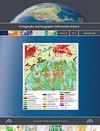Elastic beam algorithm for generating circular cartograms
IF 2.4
3区 地球科学
Q1 GEOGRAPHY
Cartography and Geographic Information Science
Pub Date : 2022-04-27
DOI:10.1080/15230406.2023.2196732
引用次数: 1
Abstract
ABSTRACT The circular cartogram, also known as the Dorling map, is a widely used tool for visualizing statistical data. It represents regions as circles with their areas in proportion to the statistical values and requires circle displacement to avoid overlap and maintain spatial relationships. In this paper, we propose a new approach for circular cartogram production that utilizes the elastic beam displacement algorithm in cartographic generalization. First, the initial circles are generated with their areas in proportion to the statistical values. Second, an elastic beam structure is built as a proximity graph based on the spatial relations between the circles. Third, the circles violating the quality requirements are considered to have a force on the nodes of a beam. Fourth, the elastic beam algorithm is applied to assign forces for each node to determine the new positions of the circles. Steps two through four are repeated until a circular cartogram that meets the defined quality requirements is obtained. The experiments indicate that the proposed approach can successfully generate circular cartograms without overlaps while maintaining topology and relative relationships with higher quality than existing approaches. Project website: https://github.com/TrentonWei/DorlingMap生成圆形地图的弹性梁算法
圆形地图,也称为多林地图,是一种广泛使用的统计数据可视化工具。它将区域表示为圆,其面积与统计值成比例,需要圆位移以避免重叠并保持空间关系。本文提出了一种利用弹性梁位移算法进行制图综合的圆形地图制作新方法。首先,生成初始圆,其面积与统计值成比例。其次,根据圆之间的空间关系,建立弹性梁结构的接近图;第三,认为不符合质量要求的圆对梁的节点有作用力。第四,采用弹性梁算法对每个节点赋力,确定圆的新位置;重复第二步到第四步,直到获得满足定义的质量要求的圆形图。实验结果表明,该方法可以成功地生成无重叠的圆形地图,同时保持拓扑和相对关系的质量高于现有方法。项目网站:https://github.com/TrentonWei/DorlingMap
本文章由计算机程序翻译,如有差异,请以英文原文为准。
求助全文
约1分钟内获得全文
求助全文
来源期刊
CiteScore
5.20
自引率
20.00%
发文量
23
期刊介绍:
Cartography and Geographic Information Science (CaGIS) is the official publication of the Cartography and Geographic Information Society (CaGIS), a member organization of the American Congress on Surveying and Mapping (ACSM). The Cartography and Geographic Information Society supports research, education, and practices that improve the understanding, creation, analysis, and use of maps and geographic information. The society serves as a forum for the exchange of original concepts, techniques, approaches, and experiences by those who design, implement, and use geospatial technologies through the publication of authoritative articles and international papers.

 求助内容:
求助内容: 应助结果提醒方式:
应助结果提醒方式:


